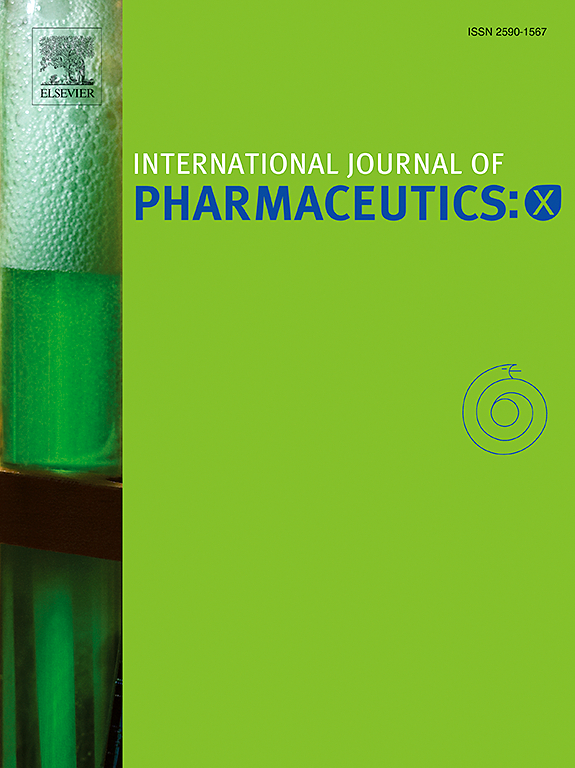The effect of black tea and water temperature on the disintegration of gelatine and HPMC capsules, tested with the paddle device, GastroDuo and in vivo pharmacokinetics: Much ado about little
IF 5.2
2区 医学
Q1 PHARMACOLOGY & PHARMACY
引用次数: 0
Abstract
Fluid co-administered with oral medication directly affects its behaviour. Often, people use fluids other than water when taking their medications. Capsules (mainly gelatine- and HPMC-based) are widely used solid oral dosage forms. The presented study aimed to investigate the behaviour of gelatine and HPMC capsules in several fluids in vitro and in vivo. The second aim was to assess the influence of administered fluids on the gastric emptying. The third aim was to assess the usability and predictive power of different in vitro methods for drug analysis and compare them with in vivo data. For in vitro studies, two systems with different complexities were used: the compendial USP 2 apparatus and the GastroDuo biorelevant model. In both systems, 25 mL of SGF and 240 mL of tested fluid were used. To obtain the in vivo data, a clinical study with 12 young and healthy volunteers was performed. In this study, the salivary tracer technique, which utilises caffeine kinetics as a marker of a dosage form behaviour in the GIT, was used. In vitro, the temperature strongly affected the opening times of gelatine capsules (rapid opening in warm media and slower in cold). In vivo, the opening time of gelatine capsules in warm black tea was slightly delayed in comparison to warm water. The differences in opening times between warm and cold water and warm black tea and cold water were significant. In USP 2 Apparatus, HPMC capsules were more sensitive to the tested media than in the biorelevant GastroDuo model. There were no significant differences in the opening times of HPMC capsules in vivo. Gastric emptying of warm water, cold water or warm black tea was not affected, suggesting that the altered in vivo absorption kinetics was caused by the in vivo behaviour of the capsules, depending on their properties and not by changes in the gastric emptying of the co-administered fluids. The presented study allows a better understanding of gelatine and HPMC capsules behaviour in vitro and in vivo administered with different fluids. Moreover, it demonstrated the relevance of in vivo data as well as the limitations of in vitro tools.
红茶和水温对明胶和HPMC胶囊崩解的影响,用桨式装置、GastroDuo和体内药代动力学试验:小题大做
液体与口服药物联合使用直接影响其行为。通常,人们在服用药物时使用液体而不是水。胶囊(主要以明胶和hpmc为基础)是广泛使用的固体口服剂型。本研究旨在研究明胶和HPMC胶囊在几种液体中的体外和体内行为。第二个目的是评估给药液体对胃排空的影响。第三个目的是评估不同体外药物分析方法的可用性和预测能力,并将其与体内数据进行比较。对于体外研究,使用了两种不同复杂性的系统:药典usp2装置和GastroDuo生物相关模型。在两个系统中,使用25 mL SGF和240 mL测试液。为了获得体内数据,对12名年轻健康的志愿者进行了临床研究。在这项研究中,使用了唾液示踪技术,该技术利用咖啡因动力学作为GIT中剂型行为的标记物。在体外实验中,温度强烈影响明胶胶囊的打开时间(在热培养基中快速打开,在冷培养基中缓慢打开)。在体内,与温水相比,温红茶中明胶胶囊的打开时间略有延迟。温水和冷水、温水红茶和冷水在打开时间上的差异是显著的。在usp2仪器中,HPMC胶囊对被测介质的敏感性高于生物相关的GastroDuo模型。HPMC胶囊在体内的打开时间无显著差异。温水、冷水或温红茶的胃排空不受影响,这表明体内吸收动力学的改变是由胶囊的体内行为引起的,取决于它们的性质,而不是由共同给药的液体的胃排空变化引起的。提出的研究允许更好地了解明胶和HPMC胶囊的行为在体外和体内与不同的液体管理。此外,它证明了体内数据的相关性以及体外工具的局限性。
本文章由计算机程序翻译,如有差异,请以英文原文为准。
求助全文
约1分钟内获得全文
求助全文
来源期刊

International Journal of Pharmaceutics: X
Pharmacology, Toxicology and Pharmaceutics-Pharmaceutical Science
CiteScore
6.60
自引率
0.00%
发文量
32
审稿时长
24 days
期刊介绍:
International Journal of Pharmaceutics: X offers authors with high-quality research who want to publish in a gold open access journal the opportunity to make their work immediately, permanently, and freely accessible.
International Journal of Pharmaceutics: X authors will pay an article publishing charge (APC), have a choice of license options, and retain copyright. Please check the APC here. The journal is indexed in SCOPUS, PUBMED, PMC and DOAJ.
The International Journal of Pharmaceutics is the second most cited journal in the "Pharmacy & Pharmacology" category out of 358 journals, being the true home for pharmaceutical scientists concerned with the physical, chemical and biological properties of devices and delivery systems for drugs, vaccines and biologicals, including their design, manufacture and evaluation. This includes evaluation of the properties of drugs, excipients such as surfactants and polymers and novel materials. The journal has special sections on pharmaceutical nanotechnology and personalized medicines, and publishes research papers, reviews, commentaries and letters to the editor as well as special issues.
 求助内容:
求助内容: 应助结果提醒方式:
应助结果提醒方式:


